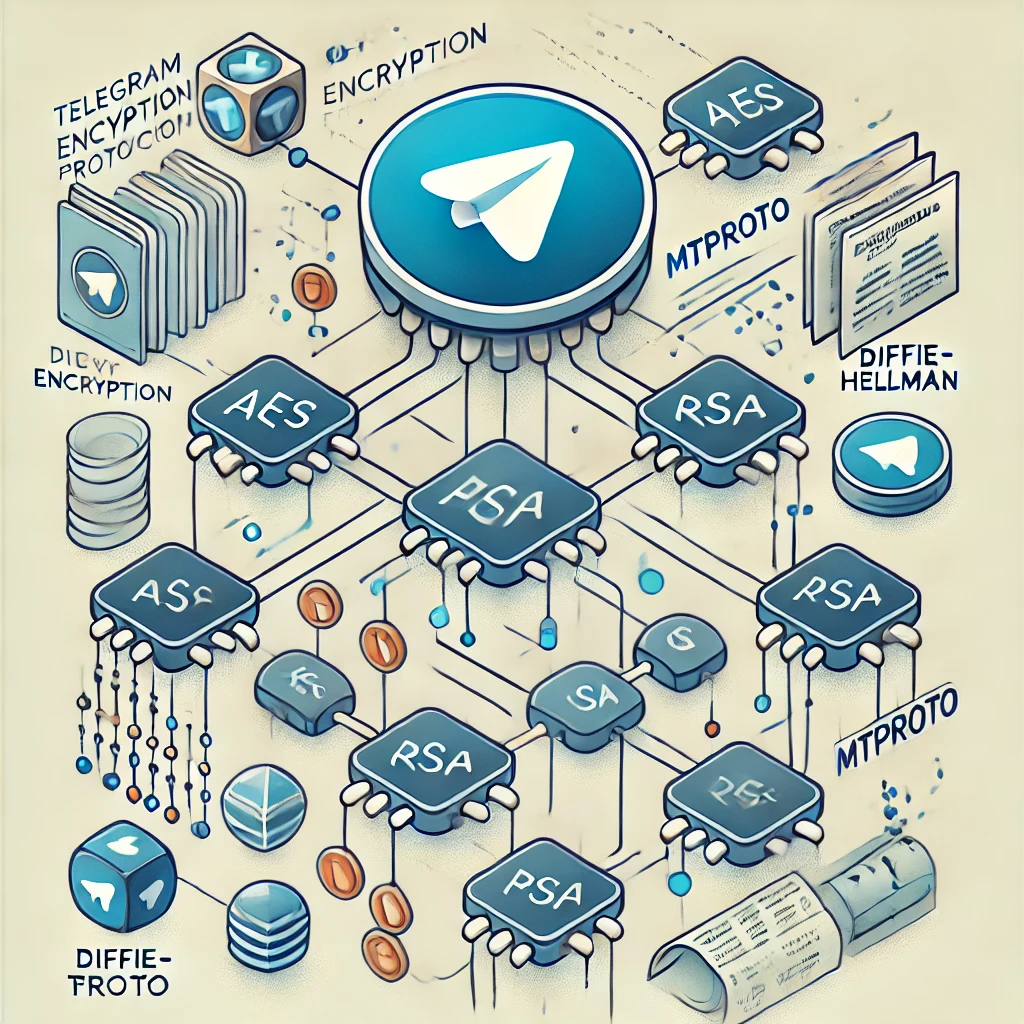In an era where digital communication dominates our daily lives, the quest for a secure messaging platform seems to be never-ending. Enter Telegram: a name that echoes through the corridors of modern messaging apps, promising speed, security, and simplicity. But just how secure is Telegram? This question isn’t just casual chat fodder; it’s a pivotal concern for anyone sharing a slice of their digital life on this globally popular platform.
Telegram, founded by the enigmatic Durov brothers, has always positioned itself as the Fort Knox of messaging apps. With a user base rapidly expanding into the hundreds of millions, it pledges to shield your messages from prying eyes with robust encryption protocols. But in the shadow of such bold claims, skepticism looms large. Is Telegram truly the digital fortress it claims to be, or just another castle built on sand? Today, we delve deep into its security architecture to unearth the truth.
Our investigation isn’t just a dry recital of technical jargon. We’ll cut through the complexities of MTProto, Telegram’s home-grown encryption algorithm, and explore what encryption really means for your daily chats. Are all your messages securely locked away from unwanted scrutiny, or could someone find a master key? And for the curious minds wondering how to send a message to yourself on Telegram, we’ll cover that too—showcasing just one of the quirky features that make this app intriguing beyond its security claims.
As we prepare to pull back the curtain on Telegram’s security practices, remember: in the world of digital privacy, not all is as it seems. Let’s uncover whether Telegram is your trustworthy confidant or just another actor on the stage of digital drama.
Exploring the Security Architecture of Telegram
When discussing how secure Telegram is, it’s imperative to start at the foundation: its security architecture. The core of Telegram’s defense against cyber threats is its proprietary encryption protocol, MTProto. Developed with both speed and security in mind, this protocol is both lauded for its unique approach and scrutinized by the cryptology community. But what’s all the fuss about?

MTProto employs a blend of 256-bit symmetric AES encryption, 2048-bit RSA encryption, and Diffie-Hellman secure key exchange. “Impressive,” you might say, but in the realm of cybersecurity, the devil is in the details. This protocol is not just a technical fortress; it’s a statement from Telegram that they take your privacy seriously—perhaps more seriously than some of their more mainstream competitors.
But here’s where the skepticism kicks in: Telegram’s encryption is cloud-based by default, meaning that your messages are securely encrypted on their servers but are decrypted on their side of the channel. This has raised a few eyebrows. Why? Because it theoretically allows Telegram to access your messages. They assert that they do not use this capability for anything other than maintaining your chat logs, thus facilitating seamless synchronization across devices. But for the privacy purists, this is a compromise they’re unwilling to make. That’s why Telegram offers something more—Secret Chats.
Secret Chats are where Telegram takes a bow to the privacy advocates. These are not cloud-based but are instead meant for your eyes only. Using end-to-end encryption, messages in Secret Chats can only be read on the device used to send and receive them. No middle-man, not even Telegram’s servers, get to peek. Every message sent has its own unique lock and key, all of which are controlled by you and the recipient. If James Bond used a messaging app, this would probably be his choice.
Moreover, for those who find solace in the ephemeral, Secret Chats offer self-destructing messages. Think of it as a conversation written in disappearing ink—once it’s gone, it’s gone forever, or so we hope. This feature adds an extra layer of security by ensuring that no digital footprints are left behind, thereby fortifying the walls of your digital fortress.
As we peel back the layers of Telegram’s security, it’s clear that it’s designed to cater to both the average user and the privacy enthusiast. Whether you’re exchanging mundane day-to-day pleasantries or top-secret information, Telegram asserts that it has you covered. However, let’s not put on our rose-colored glasses just yet—how does this architecture hold up in the real world? Stay tuned as we delve deeper into the practical implications of Telegram’s security measures in everyday communication.
Learn about the latest encryption technologies to see how Telegram’s protocols compare to industry standards.
How Secure is Telegram for Daily Communications?
As we’ve seen, Telegram’s security architecture is built like a high-tech vault. But when it comes to the brass tacks—everyday communication—how secure is Telegram, really? Let’s unpack the reality of everyday chats, where the nuances of privacy concerns meet the plain-speak of the average user.

For the typical user, Telegram’s default chat settings offer more than your garden-variety encryption. Unlike other popular messaging platforms that encrypt messages in transit but store them in plain text on their servers, Telegram adds an extra layer. All data is encrypted on the server side using the MTProto protocol, which, while impressive, has stirred some debate. Critics often point out that server-side encryption places a lot of trust in Telegram’s promise not to peek. True, Telegram has stood by its pledge with a commendable track record, but skeptics will always question: What if?
In everyday usage, this means your casual chats about dinner plans, weekend getaways, and family updates are shielded from the typical eavesdropper. However, the story tweaks a bit when discussing more sensitive information. For those deeply concerned about privacy, the non-default but readily available “Secret Chats” feature is Telegram’s nod to the paranoid among us. Here, end-to-end encryption ensures that only you and the recipient can read what’s sent, with nothing stored on servers to worry about. This feature isn’t just for the tin-foil-hat crowd; it’s for anyone who wants that extra assurance that their conversations are for their eyes only.
Adding to this, Telegram’s self-destructing messages feature in Secret Chats offers a James Bond-esque flair to your daily messaging. Planning a surprise party or sharing sensitive work information? Set your messages to self-destruct, and poof—they’re gone once read. This isn’t just cool; it’s practical, reducing the digital footprint of your more sensitive communications.
Yet, how does Telegram fare against other giants in the messaging world? When you pit it against the likes of WhatsApp or Signal, Telegram stands out for its blend of user-friendly features with robust security measures—though it’s worth noting that each app has its unique approach to user privacy and data protection.
As we move forward, keep in mind that while Telegram does an excellent job of balancing convenience with security, no system is entirely foolproof. The savviest users will always weigh their options, considering what level of security they need versus what they’re willing to compromise. Transitioning into the finer details of user privacy, let’s explore how Telegram handles your personal data and whether its privacy policies are as tight as its security protocols.
User Privacy and Data Protection on Telegram
When evaluating how secure Telegram is, particularly from the perspective of user privacy and data protection, the narrative deepens beyond just encryption protocols to the very core of personal data management. Telegram touts a strong privacy policy, famously resistant to external pressures for data disclosure, but what does this mean for you, the user?
At its heart, Telegram’s approach to data privacy is rooted in the concept of minimal data retention. Unlike some platforms that seem to hoard every byte of data they can get their hands on, Telegram collects only what is necessary for the service to function. This includes your phone number (used for identification and login) and your contacts list, if you permit access, to help you connect with others. Intriguingly, Telegram does not store your messages on their servers once they have been delivered to all intended recipients; messages in ‘Secret Chats’ are never stored on any server to begin with.
However, this doesn’t mean Telegram is a data-free utopia. The server-side encryption model for standard chats means that your messages do reside on Telegram’s servers until they are delivered. Although these messages are encrypted, the keys are also stored at the same location, which some critics argue could become a potential vulnerability—if not against external hackers, perhaps against internal breaches or legal pressures.
Moreover, Telegram’s privacy policy highlights a nuanced stance when it comes to data requests from law enforcement. While steadfast in their promise to protect user data, they clarify that in extreme cases of terror-related communications, they might relent to legal pressures. This admission is both a testament to their commitment to global safety and a point of contention for privacy purists who argue that any avenue for data disclosure is a potential privacy leak.
In day-to-day use, these policies mean that for the average user, Telegram offers a robust level of privacy protection, significantly more than some competitors. But for the privacy-centric user, the distinction between Telegram’s standard and Secret Chats becomes crucial. It’s a digital crossroads of sorts: one path offers convenience and accessibility, while the other offers stringent privacy at the cost of some functionality.
Navigating these privacy concerns requires more than just knowing the features. It calls for an understanding of the practical implications of these policies—how they affect real-world use and what they mean in the event of a security breach. As we segue into examining past security breaches and assessing Telegram’s response to these crises, it becomes clear that understanding Telegram’s approach to privacy is not just about reading through their policies but seeing them in action.
For more comprehensive strategies on safeguarding your digital life, explore our detailed guide on protecting your online privacy.
How to Send a Message to Yourself on Telegram
In the sprawling world of Telegram, with its secure channels and secretive chats, there exists a surprisingly simple yet profoundly useful feature: sending a message to yourself. This function turns your chat list into a notepad, a storage locker, and a personal archive all rolled into one, but how exactly do you tap into this lesser-known feature?
Sending a message to yourself on Telegram is as straightforward as starting a new chat. Instead of searching for another contact, you type your own name in the search bar. You will appear as a contact in the search results, usually marked clearly to distinguish from others with similar names. Clicking on your profile opens a chat window—the same kind you would use to message anyone else on the platform. Here, you can type messages, send files, links, and even forward messages from other chats. Think of it as a digital scratchpad that travels with you across all your devices, thanks to Telegram’s cloud-based synchronization.
Why would you want to send a message to yourself, though? The uses are as varied as they are imaginative. From storing digital receipts and travel tickets to keeping track of to-do lists and brainstorming ideas, this feature can be an organizational powerhouse. It’s particularly handy for those who toggle between multiple devices, as everything you send to this chat will be accessible wherever you log into your Telegram account.
This functionality extends beyond mere text messages. Users frequently use their self-chat as a repository for files, making Telegram a cloud storage service where they can quickly retrieve PDFs, images, or documents. Given Telegram’s generous file size limits, it’s an efficient way to keep important files within reach, secured by Telegram’s encryption protocols.
While some might overlook the importance of such a feature, in the grand scheme of things, it embodies the versatility and user-centric design that Telegram prides itself on. It’s not just about security or privacy; it’s about creating a seamless user experience. This clever use of a messaging platform shows just how much Telegram understands the needs of its users—from the everyday chatter to the power user seeking efficiency and security in every aspect of digital communication.
As we continue to explore the intricate tapestry of features that Telegram offers, this simple yet effective tool highlights the broader implications of what Telegram promises: not just a messaging app, but a comprehensive tool for digital life management. Let’s delve deeper into the practical implications of Telegram’s security measures and how they translate into real-world usage.
Real-World Tests and Security Breaches
When considering how secure Telegram is, theoretical assurances and cryptographic algorithms only tell half the story. It’s in the real world, amidst the chaos of digital skirmishes and data breaches, that the robustness of any security system is truly tested. For Telegram, a platform that has positioned itself as a bastion of privacy, how does it hold up under scrutiny and past security challenges?
Let’s unpack some of the publicized security breaches and vulnerabilities that have put Telegram to the test. Notably, in its early years, Telegram faced criticism for using a home-brewed encryption method, MTProto, which some cryptographers argued hadn’t been sufficiently battle-tested in the wild. Skeptics worried that any encryption not subject to rigorous peer review might harbor unseen flaws. However, despite these concerns, no substantial breach has publicly compromised Telegram’s core messaging services. This is a testament not only to the architecture’s initial design but also to Telegram’s ongoing efforts to patch and update their systems as new threats emerge.
However, this isn’t to say that Telegram has been entirely unscathed. There have been instances where user accounts were hijacked through SMS-based attacks, exploiting the telecommunications infrastructure rather than the app itself. These incidents highlighted a critical point: the security of a messaging app isn’t just about the app’s code but also about the ecosystem in which it operates. In response, Telegram has bolstered its security measures, offering two-factor authentication to provide users with an additional layer of security beyond the traditional SMS verification.
Moreover, Telegram’s approach to handling such crises reveals a lot about its commitment to security. Each time a potential vulnerability is reported, Telegram has been quick to respond, often rewarding researchers through its bug bounty program, which incentivizes the identification and reporting of security flaws. This proactive stance is crucial in maintaining the trust of millions of users who rely on Telegram for secure communication.
Yet, the landscape of cybersecurity is a constantly evolving battleground. As new threats emerge, the real test for Telegram will continue to be its ability to adapt and respond to new challenges. How it learns from past breaches and fortifies its defenses not only affects user trust but also shapes the broader narrative around digital privacy and security.
As we pivot from discussing past breaches to exploring what experts have to say about Telegram’s current security stature, it becomes clear that the conversation around security is as much about resilience and response as it is about prevention. Let’s dive deeper into what cybersecurity experts have to say, providing a panoramic view of Telegram’s security in the modern digital age.
Ensure your system is secured against all threats with our ultimate guide to cybersecurity tips for Windows 10.
What Experts Say About Telegram’s Security
In the quest to understand how secure Telegram really is, turning to industry experts provides invaluable insights that cut through the usual marketing fluff. These security pundits, cryptographers, and tech analysts offer a spectrum of views that range from high praise to cautious skepticism, painting a comprehensive picture of Telegram’s security landscape.
Many experts commend Telegram for its bold approach to user privacy and security, particularly with features like end-to-end encryption in Secret Chats and self-destructing messages. Dr. Elaine Barker, a noted cryptographer, states, “Telegram has made significant strides in securing user data against conventional eavesdropping techniques. However, their reliance on a proprietary encryption protocol, MTProto, while unique, does not have the same level of transparency as open-source solutions which can be more broadly scrutinized by the global security community.” This sentiment is echoed in the broader security community, which generally favors open-source protocols for their verifiability and community-driven security audits.
Yet, it’s not all smooth sailing. Some experts point out the potential vulnerabilities associated with Telegram’s server-side encryption model for regular chats. As cybersecurity analyst Tom Sanders explains, “While Telegram’s encryption is robust, the architecture of storing encryption keys on their servers poses inherent risks. Should those servers ever be compromised, it could expose a significant amount of user data.” This highlights a critical trade-off between user convenience and absolute security.
Moreover, the responsiveness of Telegram to security challenges receives mixed reviews. Jennifer Hart, a security consultant, praises Telegram’s proactive nature: “Their quick updates and patches following any reported vulnerabilities demonstrate a commitment to security that is commendable.” However, she cautions that “No system can be entirely foolproof, and users should leverage all available security features, like two-factor authentication, to safeguard their communications.”
As we dissect these expert analyses, it becomes evident that Telegram’s security isn’t just about the technology itself, but also about how it’s implemented and the ongoing commitment to safeguarding it against evolving threats. The consensus suggests that while Telegram offers more privacy controls than many mainstream messaging apps, users must stay informed and vigilant, using features like Secret Chats for their most sensitive communications.
This nuanced perspective from the experts sets the stage for us to delve deeper into the practical steps users can take to maximize their security on Telegram. By understanding the strengths and potential weaknesses highlighted by these experts, users can better navigate their digital interactions with confidence. Let’s explore these actionable insights and best practices in our next section, ensuring you’re not just using Telegram, but using it securely.
Telegram Security Queries Unwrapped
Diving into the world of Telegram, several queries bubble up from the community and potential users concerning how secure Telegram really is. It’s time to unwrap these questions with a touch of expertise and a sprinkle of skepticism, ensuring every reader walks away more informed and empowered.
1. Can Telegram read my messages?
A hot topic indeed. For standard cloud chats, Telegram holds the encryption keys, meaning technically, they could access message data. However, they assert that they only use this capability for delivering messages across devices and ensuring functionality—not for snooping. For full privacy, Secret Chats are your go-to, as they are end-to-end encrypted and not accessible to anyone but you and the recipient.
2. What happens if I lose my device—can someone access my Telegram chats?
Losing a device doesn’t necessarily mean losing your private data. Telegram’s server-side encryption safeguards your messages from being exposed if your phone is compromised. Moreover, you can use another device to remotely log out of the lost device, securing your data further. Enable two-factor authentication to add an additional layer of security, just in case.
3. Are my group chats encrypted?
Yes, but there’s a twist. While all Telegram messages use encryption, group chats do not benefit from the same end-to-end encryption that Secret Chats do. This means the data in group chats is encrypted on the way to and from Telegram’s servers but is decrypted on the servers themselves. For ultra-sensitive discussions, sticking to one-on-one Secret Chats might be wiser.
4. How does Telegram handle deleted messages?
When you delete a message on Telegram, it’s supposed to vanish for good—no ifs, ands, or buts. This applies across the board, for both you and the recipient, in all types of chats. However, the ephemeral nature of digital data means that ultimate data security often relies on trust in the platform’s execution of these policies.
As we peel back the layers of common inquiries, it becomes evident that while Telegram offers robust security features, the platform requires users to actively engage with and understand these features to fully benefit from them. It’s not just about having tools at your disposal but knowing when and how to use them.
By tackling these frequently asked questions, we aim not only to dispel myths but also to equip you with the knowledge to use Telegram more securely and confidently. Now, as we transition from addressing these queries to summarizing the key insights gleaned from our exploration, let’s ensure that you’re not only well-informed but also ready to apply this knowledge practically in your daily digital communications.
Telegram Security: The Bottom Line
After unpacking layers of encryption, privacy policies, expert opinions, and user concerns, the core question remains: How secure is Telegram for your daily digital exchanges? Let’s distill the essentials and lay out the bottom line, while keeping our critical lenses polished and our humor at the ready.

Telegram stands out in the crowded messaging app market primarily due to its robust encryption protocols, particularly its acclaimed Secret Chats feature, which offers end-to-end encryption. This should give peace of mind to those who fear eavesdroppers might intercept their cat photos or more confidential communiques. However, for standard chats, remember that messages are encrypted but not beyond the reach of Telegram itself, given that the encryption keys are also housed on their servers.
Here’s the kicker: while Telegram offers formidable security features, the strength of its security largely depends on the user’s choices. Opting for Secret Chats, enabling two-factor authentication, and understanding the limitations of group chats are crucial steps users should take to fortify their communication fortress.
Moreover, Telegram’s commitment to user privacy, despite being occasionally challenged by legal and ethical pressures, has been mostly steadfast. They have continually pushed back against external pressures for data disclosure, although they concede to cooperating in cases of severe criminal allegations, which might be a gray area for privacy purists.
As we wrap up our exploration, it’s clear that Telegram does a commendable job of balancing security with functionality, offering more control over privacy than many competitors. However, the optimal use of its features—and therefore, the security you derive from them—is much like a dance that requires both the right steps and a keen awareness of the rhythm.
Moving forward, as digital landscapes evolve and new threats emerge, keeping abreast of changes in Telegram’s security measures and adapting your usage accordingly will be key. By staying informed and proactive, users can ensure that their communication remains as secure as possible within the realms of Telegram’s innovative yet occasionally contentious platform.
In conclusion, while no platform can offer perfect security, Telegram provides a compelling suite of features that, when used correctly, can significantly enhance privacy and security for its users. Now, armed with this knowledge, you’re better equipped to navigate the nuances of digital communication on Telegram, ensuring that your data not only stays private but also truly serves your needs in the ever-expanding universe of online messaging.


